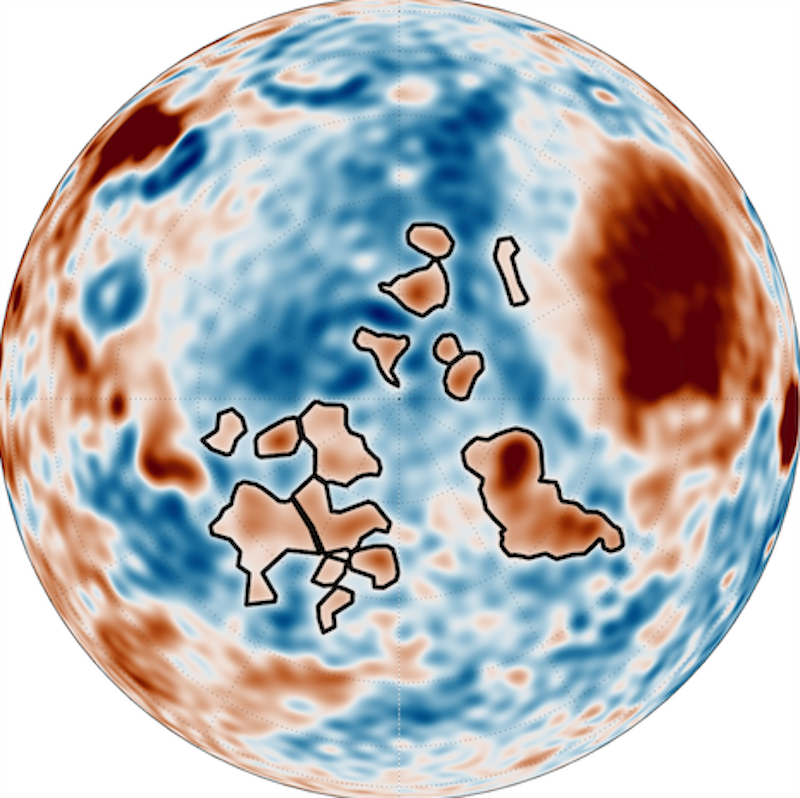
- Mars is geologically rich beneath its surface. It has extensive deposits of ice and perhaps even liquid water in its depths. What else is underground on Mars?
- Scientists have found about 20 “structures” below the surface of Mars. They are denser than the surrounding rock and are buried under a thick layer of sediment in the planet's northern hemisphere. The sediment could come from an ancient ancient ocean on Mars.
- A huge pool of lava It could also be found beneath Olympus Mons, the largest volcano on Mars. Lava appears to be rising toward the surface of Mars.
Surprises from a new gravity map of Mars
Scientists have discovered multiple dense features or large-scale “structures” beneath the northern hemisphere of Mars. The massive structures are buried beneath a soft layer of sediment, which scientists believe comes from an ancient ancient ocean. Additionally, there is also evidence of active processes, possibly lava, beneath Mount Olympusthe largest volcano on Mars. Researchers at Delft University of Technology (TU Delft) in the Netherlands saying on September 13, 2024, they made the findings using a new gravity map of Mars, with data from multiple missions to Mars.
The researchers, led by Bart's root from TU Delft, presented their findings at the Europlanet 2024 Scientific Congress earlier this month. You can read the summary. here.
Studies of gravity variations on Mars have revealed dense, large-scale structures hidden beneath the sediment layers of a lost ocean. The findings have been presented in the #EPSC2024 by Bart Root @tudelft: https://t.co/6Y9F5XBkAS pic.twitter.com/dLPNaNVtBb
—Europlanet? (@europlanetamedia) September 13, 2024
Features hidden beneath Mars' buried ocean sediments?
The dense structures are found in the northern hemisphere of Mars, in the planet's crust. They are significantly denser than other surrounding rocks. Additionally, they lie beneath a thick, soft layer of sediment. The researchers said this sediment likely came from an ancient ancient ocean in the northern hemisphere of Mars. This is something that scientists have also discussed and debated for decades.
In total there are about 20 unusual structures of different sizes. They are about 300 to 400 kg/m3 (kilograms per cubic meter/19 to 25 pounds per cubic foot) denser than the surrounding rock. So what are they? as root explained:
These dense structures could be of volcanic origin or could be material compacted due to ancient impacts. There are around 20 features of different sizes that we have identified spread across the area surrounding the north polar cap, one of which resembles the shape of a dog.
The anomalies are completely buried and there are no signs of them on the Martian surface. Added root:
There seems to be no trace of them on the surface. However, through the gravity data, we have a tantalizing glimpse into the earliest history of Mars' northern hemisphere.
Discovery of anomalies.
So how did the researchers find these unusual features? They created a gravity map of Mars by observing small deviations in the orbits of spacecraft around the planet. The researchers analyzed those deviations for clues about the internal structure and mass distribution of Mars. Gravitational variations within Mars can show differences in the density of any subsurface geological structure.
Meanwhile, NASA InSight lander The mission had studied the Martian crust, including its thickness and flexibility. The research team combined data from InSight with data from the orbiters in a new computer model. In addition, they included data from the depths of the Mars mantle. The resulting gravity map revealed the location of the dense structures beneath the surface.
Lava below Mount Olympus?
Furthermore, apart from the dense anomalies, the map showed something else. He tarsis The region is a huge volcanic plateau, which includes Olympus Mons, the largest volcano on Mars. Scientists knew that a region of weaker gravity and lower density surrounds the plateau. But why? The new map provided some clues. There is a huge mass of lighter material beneath it, about 1,740 kilometers (1,080 miles) wide and 1,095 kilometers (680 miles) deep. The researchers said this material could explain why Tharsis has a much higher elevation than the surrounding terrain.
In fact, according to the new study, that material could be lava. It is moving toward the surface, causing upwelling. Root saying:
NASA's InSight mission has given us vital new information about the tough outer shell of Mars. This means that we must rethink how we understand the support of the Olympus Mons volcano and its surroundings. It shows that Mars could still have active movements within it, affecting and possibly creating new volcanic features on the surface.
Martian quantum gravity mission
Determining exactly what the subsurface structures are will require a follow-up mission. That is where the Martian Quantum Gravity proposal arises (MaQuls) the mission arrives. It will study variations in gravity and use some of the same technology as the GRAIL and FUNNY missions. GRAIL studied the Moon's gravitational field, while GRACE measured Earth's gravitational field and more.
Lisa Wörner at the German Aerospace Center (DLR) saying:
Observations with MaQuIs would allow us to better explore the subsurface of Mars. This would help us find out more about these mysterious hidden features and study them in progress. mantle convectionin addition to understanding dynamic surface processes, such as atmospheric seasonal changes and the detection of groundwater deposits.
Bottom line: A new gravity map of Mars shows strange structures hidden beneath the surface of Mars. Some could be related to an ancient ocean. Others could be lava!
Through the Europlanet Society
Read more: What the Chinese Zhurong rover found beneath the surface of Mars
Read more: Is Mars volcanically active?